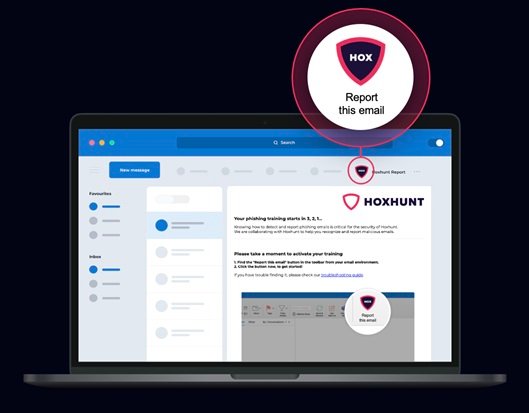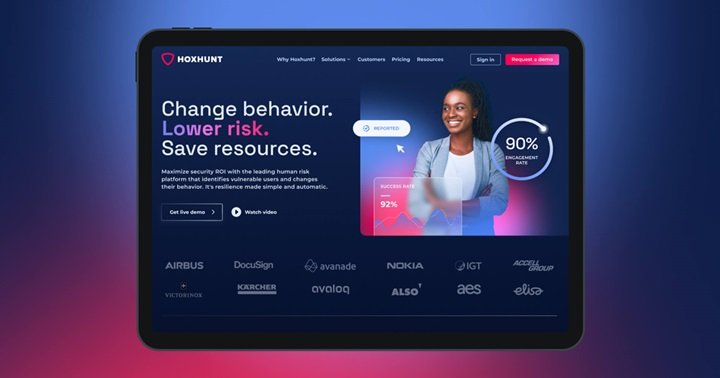Table of Contents
In the ever-evolving landscape of cybersecurity, the human element often poses the most significant risk. Despite advanced firewalls and encryption, a simple human error can open the door to devastating cyber attacks. Enter Hoxhunt, a company that leverages AI and behavioral science to transform employees from potential liabilities into powerful defenders against cyber threats.
What is Hoxhunt?
Hoxhunt is an innovative cybersecurity platform designed to mitigate the risks associated with employee behaviors. By using a blend of artificial intelligence (AI) and behavioral science, Hoxhunt trains employees to recognize and respond to phishing attempts and other social engineering tactics. The goal is not just to teach employees what to look for, but to fundamentally change their behavior towards cybersecurity threats.
How Does Hoxhunt Work?
Hoxhunt’s approach is both smart and practical. It begins with simulating phishing attacks tailored to individual employees’ behavior patterns. The AI component of Hoxhunt analyzes how each employee interacts with these simulations, continuously adapting and personalizing the training to ensure it is relevant and effective.
Here’s a step-by-step breakdown of how Hoxhunt operates:
- Simulation: Hoxhunt sends realistic, simulated phishing emails to employees.
- Analysis: The platform’s AI analyzes how employees respond, identifying who falls for the traps and who successfully avoids them.
- Training: Employees who fall for the simulation are provided with immediate, interactive training modules that explain what went wrong and how to improve.
- Reinforcement: Over time, Hoxhunt continuously adapts the difficulty and style of simulations based on the employee’s performance, ensuring a personalized learning experience.

Real-Life Examples of Hoxhunt in Action
Let’s look at some real-life examples to illustrate how Hoxhunt’s approach works and the impact it can have:
Example 1: The Finance Department In one company, the finance department was particularly vulnerable to phishing attacks due to the nature of their work. They often dealt with invoices and payment requests, making them prime targets for attackers. Hoxhunt tailored phishing simulations that mimicked typical finance-related scams. Over time, employees in the finance department became adept at spotting even the most convincing phishing attempts. As a result, the company saw a significant reduction in successful phishing attacks, saving potentially millions in fraudulent transactions.
Example 2: The Remote Workforce During the COVID-19 pandemic, many companies shifted to remote work, increasing the risk of cyber attacks. One organization integrated Hoxhunt to train their remote employees. Through regular, tailored simulations, employees quickly adapted to the new working environment’s unique threats. For instance, they learned to identify phishing attempts disguised as IT support emails, which became common during the transition to remote work. This proactive training helped the company maintain robust cybersecurity despite the sudden change in work dynamics.
The Science Behind Hoxhunt
Hoxhunt’s success lies in its foundation in behavioral science. Traditional cybersecurity training often involves one-off sessions that employees quickly forget. In contrast, Hoxhunt employs principles from behavioral psychology to ensure lasting behavioral change.
- Repetition and Reinforcement: Hoxhunt’s continuous simulations and feedback loop reinforce learning. Just as habits are formed through repeated behavior, cybersecurity awareness becomes second nature through ongoing practice.
- Personalization: The platform’s AI personalizes training based on individual behaviors. This targeted approach ensures that employees receive training that directly addresses their weaknesses, making it more effective.
- Positive Reinforcement: Hoxhunt rewards employees for successfully identifying phishing attempts. This positive reinforcement encourages vigilance and makes employees feel like active participants in the company’s cybersecurity efforts.
Why Hoxhunt is Essential for Modern Businesses
Cyber threats are evolving rapidly, and attackers are becoming more sophisticated. Traditional cybersecurity measures, while necessary, are not sufficient on their own. Human error remains a significant vulnerability, and Hoxhunt addresses this gap effectively.
1. Adapting to New Threats: Hoxhunt’s AI constantly updates simulations based on the latest phishing techniques, ensuring employees are always prepared for new threats.
2. Employee Engagement: The interactive and personalized nature of Hoxhunt’s training keeps employees engaged and motivated. Unlike mundane training sessions, Hoxhunt makes learning about cybersecurity an ongoing and dynamic process.
3. Building a Security Culture: By integrating cybersecurity training into the daily routine, Hoxhunt helps build a culture of security within the organization. Employees become proactive defenders, not just passive participants in cybersecurity.
Conclusion
In the battle against cyber threats, the weakest link is often the human element. Hoxhunt’s innovative use of AI and behavioral science turns this vulnerability into a strength, empowering employees to act as the first line of defense. By transforming how employees perceive and react to cyber threats, Hoxhunt not only mitigates risks but also fosters a culture of security that is essential in today’s digital age.
For businesses looking to enhance their cybersecurity posture, integrating Hoxhunt into their training programs is a strategic move. It’s not just about protecting data; it’s about creating a resilient organization where every employee plays a crucial role in safeguarding against cyber threats.

Frequently Asked Questions about Hoxhunt
What is the meaning of Hoxhunt?
Hoxhunt is a cybersecurity platform that utilizes AI and behavioral science to train employees in recognizing and responding to phishing attempts and other cyber threats. The name “Hoxhunt” reflects the platform’s proactive approach to hunting and mitigating “hoaxes” or deceptive cyber attacks, ensuring employees are vigilant and prepared.
Where is Hoxhunt headquarters?
Hoxhunt is headquartered in Helsinki, Finland. This innovative company has a global presence, providing cutting-edge cybersecurity training solutions to organizations worldwide.
Why Hoxhunt?
Hoxhunt stands out for its unique approach to cybersecurity training. By combining AI and behavioral science, Hoxhunt delivers personalized, continuous training that effectively changes employee behavior towards cyber threats. This proactive method not only reduces the risk of successful cyber attacks but also fosters a culture of security within organizations.
What is Proofpoint Security Awareness Training?
Proofpoint Security Awareness Training is a cybersecurity training solution that helps organizations educate their employees about various cyber threats. Like Hoxhunt, Proofpoint focuses on phishing simulations and other threat scenarios to enhance employees’ ability to identify and respond to cyber attacks. However, each platform has its unique features and methodologies.
Hoxhunt Phishing?
Hoxhunt specializes in phishing simulations as a core component of its training program. These simulations mimic real-world phishing attempts, helping employees recognize and avoid falling for such scams. By continuously exposing employees to various phishing scenarios, Hoxhunt improves their ability to detect and respond to actual phishing attacks.
Hoxhunt vs. KnowBe4?
Both Hoxhunt and KnowBe4 are prominent cybersecurity training platforms that focus on phishing simulations and employee education. While both aim to enhance cybersecurity awareness, Hoxhunt distinguishes itself through its use of AI and behavioral science to personalize and adapt training based on individual employee behaviors. KnowBe4, on the other hand, offers a wide range of training modules and tools, catering to diverse organizational needs. The choice between the two often depends on the specific requirements and preferences of an organization.




X22Gus
Hey people!!!!!
Good mood and good luck to everyone!!!!!